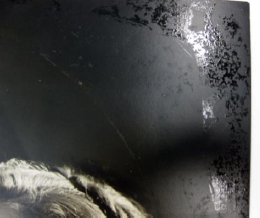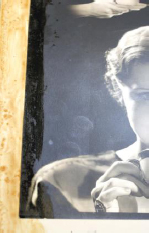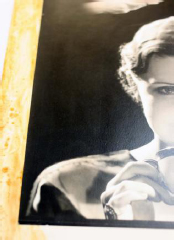
Topics in Photographic Preservation 2011, Volume 14, Article 1 (pp. 1-2)
Presented at the 2011 PMG Winter Meeting in Ottawa, Canada
The problem: 31 photographs from 1934 Art and Industry Exhibition Photograph Collection (Baker Library Historical Collections, Harvard Business School) came to the WPC for the exhibit preparation. Many of them were mounted on a paperboard with rubber cement adhesive (Figure 1). Some photographs had window mat adhered to the mat with rubber cement applied right on the top of the photograph’s edges. There was also random rubber cement staining on the image area.

Figure 2 BT

Figure 1 AT
A decision was made to leave rubber cement adhesive on the mount, but reduce as possible the adhesive on the edges of photographs (Figures 2-3).
For some photographs it was more challenging because they have also severe silver-mirroring on the edges. Any treatment to reduce the adhesive could alter the silver mirroring as well. Therefore the silver mirroring reduction treatment possibility was discussed with curator-Laura Linard and collection conservator-Priscilla Anderson as well.
The treatment process: Different organic solvents were tested in order to choose one that works best. Aceton worked fine. To give more working time and also to make it less toxic, a mixture of acetone with ethanol was tested and it worked very well as well. Then pure ethanol was tested and worked perfectly to reduce the rubber cement adhesive on gelatin emulsion. Ethanol was used with cotton pad on the edges. The movement of cotton pads was controlled in order to avoid spreading the adhesive around. Silver mirroring was reduced during the same treatment as well (Figures 4-5).

Figure 3 BT

Figure 5 AT
It was not just a cosmetic treatment, rubber cement adhesive is well known by high acidity that causes even more problems for photographs, such as fading and yellowing.
The adhesive is soluble in ethanol and it was very tempting to think about removal of the adhesive from the backs of the photographs. But this is very invasive treatment.
Since the collection stores in a cool storage with very good climate control (60° F, 40% R/H), a decision was made to leave the adhesive on the back of the photographs.
We all know that rubber cement adhesive is one of the nightmares for conservators, especially when it is on a paper surface. The reduction (in some cases removal) of the adhesive from the emulsion surface was unexpectedly easy. It does make sense because the difference in surface of paper and gelatin emulsion.
Of course in our case we had to reduce the silver mirroring as well. This decision could be controversial and always should be discussed with a caretaker of the photograph.
Papers presented in Topics in Photographic Preservation, Volume Fourteen have not undergone a formal process of peer review.